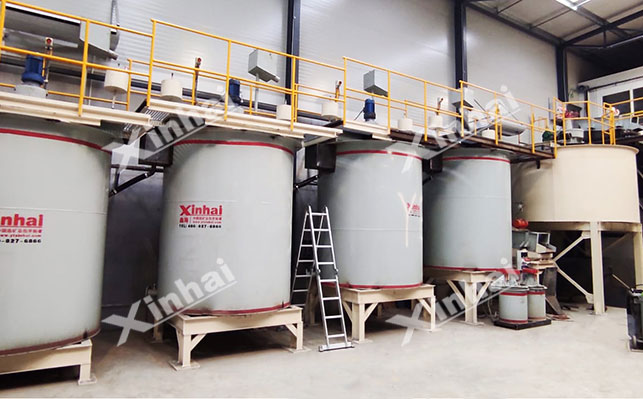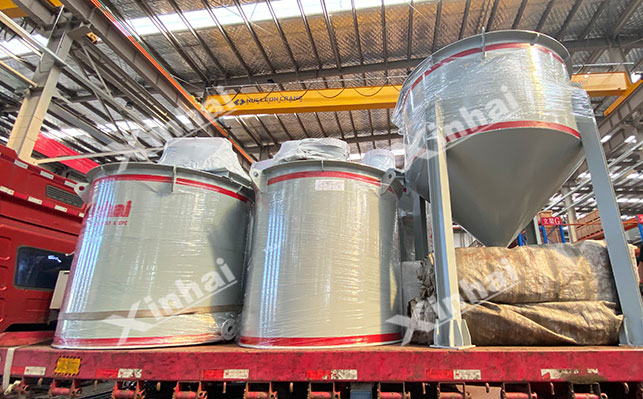
15311826613
Click to add WeChatRare earth ore is a key raw material for modern industry, and its efficient extraction is crucial. Leaching is an important method in the field of rare earth ore beneficiation. It uses chemical reagents to react with rare earth minerals to make rare earth elements enter the solution in the form of ions, thereby achieving separation from other minerals. In-depth exploration of rare earth ore leaching technology and supporting leaching equipment is of far-reaching significance for improving the efficiency of rare earth ore beneficiation and ensuring the high-quality supply of rare earth resources.

The leaching process of rare earth ore is based on the chemical reaction between rare earth minerals and specific leaching agents. Different types of rare earth ores are suitable for different leaching agents. Rare earth ores in the form of carbonates and phosphates are often leached with inorganic acids such as sulfuric acid and hydrochloric acid; when monazite ore is leached with sulfuric acid, sulfuric acid and monazite undergo a double decomposition reaction, causing rare earth elements to enter the solution in the form of sulfates.
After the leaching agent comes into contact with the rare earth mineral, not only a chemical reaction occurs, but also ion diffusion and mass transfer processes in the solution are involved. On the surface of the mineral particles, the leaching agent molecules diffuse into the interior of the mineral, react with the rare earth ions, and the generated soluble rare earth compounds diffuse back into the main body of the solution. In order to accelerate this process, it is usually necessary to increase the contact frequency between the leaching agent and the mineral through stirring, heating and other means, enhance the convection and diffusion of the solution, and ensure that the rare earth elements can be fully and quickly leached from the mineral.
For some rare earth ores with complex mineral composition and very fine rare earth mineral embedded particle size, which are difficult to effectively separate by traditional gravity separation, flotation, magnetic separation and other methods, the leaching method can break through the limitations of differences in mineral physical properties, realize the extraction of rare earth elements through chemical action, and improve resource recovery rate.
Compared with some physical beneficiation methods that can only achieve preliminary enrichment, leaching can extract rare earth elements in the ore into the solution as much as possible. After leaching, combined with appropriate solution purification and separation technology, high-purity rare earth products can be obtained to meet the stringent requirements of high-end industries for rare earth quality.

It can adapt to rare earth ores of different properties. By adjusting the type, concentration, temperature, time and other parameters of the leaching agent, the enriched material is deeply treated by the leaching method to optimize the overall beneficiation process, and the leaching method can be used in conjunction with other beneficiation methods.
When the rare earth ore grade is low and other beneficiation methods are difficult to enrich rare earths economically and efficiently, the leaching method can play an advantage. Even for ores with low rare earth content, as long as the rare earth elements can be extracted into the solution through leaching, and low-cost recovery and purification can be achieved in the subsequent process, the effective utilization of resources can be achieved.
For rare earths and a variety of other metals and non-metallic minerals that are closely coexisting, and the relationship between them is complex and interwoven, the leaching method uses chemical selectivity to dissolve rare earth minerals in a targeted manner, while minimizing the impact on other minerals, and achieving effective separation of rare earths and coexisting minerals.
Stirring leaching tank: The rare earth ore crushed to a certain particle size and the leaching agent with a pre-adjusted concentration are added to the stirring leaching tank from the feed port in a certain proportion, the stirring device is started, and the stirring paddle rotates at high speed to form a strong turbulent state of the slurry, ensuring that the ore particles are fully in contact with the leaching agent and accelerating the chemical reaction. After the set leaching time is over, the leached slag is precipitated at the bottom of the tank and discharged through the discharge port, and the solution containing rare earth ions is collected from another discharge port and enters the subsequent purification and separation links.

Heap leaching equipment: mainly includes heap leaching site, spray system, liquid collection system and other parts. The heap leaching site is generally selected in an area with slightly higher terrain, a certain slope and anti-seepage treatment at the bottom to prevent the leakage of leachate from polluting the soil and groundwater. The spray system consists of nozzles, pipes, water pumps, etc., which are used to spray the leaching agent evenly on the ore pile. The liquid collection system includes a liquid collection ditch and a liquid collection pool at the bottom, which are used to collect the solution containing rare earth ions that seep out from the ore pile. The liquid collection ditch is usually paved with anti-seepage materials and tilted toward the liquid collection pool to ensure that the solution is smoothly collected. The process is to crush large pieces of rare earth ore to a certain particle size, pile them up in the heap leaching site to form an ore pile, and spray the prepared leaching agent evenly from top to bottom on the ore pile through the spray system. Under the action of gravity, the leaching agent slowly penetrates through the ore layer, reacts with the rare earth minerals in the ore, and allows the rare earth elements to enter the solution. The seeping solution flows into the liquid collection pool along the liquid collection ditch at the bottom of the ore pile to complete the initial collection. Since there are natural pores and channels inside the ore pile, the penetration rate of the leaching agent is slow, so the heap leaching process usually takes a long time, usually several weeks or even months, to ensure that the rare earth elements are fully leached.
The above is an introduction to the rare earth leaching method and rare earth leaching equipment. In actual ore dressing plants, in addition to leaching, there are also processes such as flotation and gravity separation. However, which process is suitable depends on the properties of the rare earth ore and the requirements for purification. It is recommended to conduct ore dressing test analysis, design a reasonable rare earth ore dressing process, and select suitable rare earth ore dressing equipment.